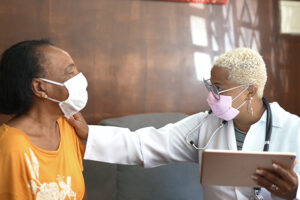Oncology
Chronic Myeloid Leukemia
Treatment-Free Remission in Chronic Myeloid Leukemia
Overview
Currently, only a subset of patients with chronic myeloid leukemia (CML) pursuing treatment-free remission (TFR) enjoy success. At the 64th ASH Annual Meeting and Exposition, researchers explored novel approaches to increase the success rates of TFR attempts.
Following these presentations, featured expert Michael J. Mauro, MD, was interviewed by Conference Reporter Editor-in-Chief Tom Iarocci, MD. Dr Mauro’s clinical perspectives on these findings are presented here.
Michael J. Mauro, MDLeader, Myeloproliferative Neoplasms Program |
|
“Regarding the best path to achieving TFR using our currently approved drugs, contemporary guidelines are fairly well worked out; however, a major question at this point is: What gets you there the fastest and the safest?”
In my experience, enthusiasm for TFR is broad across different groups of patients with CML. For example, it is not always the younger patients saying, “I’m very eager to stop,” and the older patients being more conservative and saying, “No, I’m fine; let’s leave well enough alone.” There is interest in TFR among both demographics.
There are data from patient-reported outcome studies that address patient concerns about TFR. Stress and anxiety can arise with treatment cessation attempts, and it is not for everyone. This has shaped how I approach the topic of TFR with patients: I offer it as an option, not as a directive.
This also applies to combinations that are being explored in clinical trials as a potential means of optimizing treatment. At the ASH conference, Cortes and colleagues presented data from the phase 2 ASC4MORE study (NCT03578367) of asciminib (40 or 60 mg once daily) add-on therapy to imatinib vs continued imatinib vs switch to nilotinib in patients not achieving a deep molecular response within 1 year or longer of first-line imatinib therapy (abstract 80). These patients had a good—but imperfect—response to imatinib, and the aim was to capitalize on the ability to combine asciminib, a myristoyl pocket inhibitor, with imatinib, an ATP-competitive inhibitor. The initial data showed that patients in the asciminib combination arms were doing quite well, with improving depths of remissions. The patients who stayed on imatinib did not advance much along the response spectrum, while those who switched to nilotinib did improve some but also incurred more adverse events. There were also some adverse events reported with the combination of asciminib and imatinib, but they were modest. Moving asciminib forward into earlier lines of treatment and in combination studies such as ASC4MORE is thus important and encouraging.
Since the first attempt at TFR is not always successful with our current therapies, we are also interested in approaches that might increase success rates after a second attempt at tyrosine kinase inhibitor (TKI) discontinuation. In our upcoming single-arm phase 2 trial (NCT04838041), which is sponsored by the US-based H. Jean Khoury Cure CML Consortium, we will add asciminib to imatinib to potentially increase TFR success rates in the second-attempt setting (abstract 3011). Eligibility criteria for the study include a chronic phase CML diagnosis, a previous attempt to discontinue imatinib therapy followed by a restart of imatinib at the time of molecular response, and a recovery of deeper molecular response prior to the addition of asciminib.
Regarding the best path to achieving TFR using our currently approved drugs, contemporary guidelines are fairly well worked out; however, a major question at this point is: What gets you there the fastest and the safest? Probably the most important study that we have right now is the EURO-SKI trial, which enrolled more than 800 patients and provided information about mostly imatinib-treated patients. This study detailed the kinetics of response, showing us that imatinib-treated patients likely need to be on therapy a bit longer than patients on second-generation TKIs, and that roughly 5 to 6 years of treatment and roughly 3 to 4 years of deep molecular remission would be sufficient; however, sufficient and ideal may not mean the same thing. Other studies have shown that the longer you continue treatment in deep remission, the better your chance is of achieving successful TFR, with some point of maximal return. In light of these data, the ideal path to TFR is in a state of flux, and patients individually want to know at what point the odds of success are good enough for them to reasonably consider discontinuing therapy.
Moreover, dose optimization of dasatinib has been a relatively recent development. An interesting question that emerged from the ASH conference is, essentially: “How low can we go with dasatinib and still achieve sustained deep remissions and be able to undergo TFR?” This question regarding dasatinib is quite in the spotlight now, in part because dasatinib is expected to be available in a generic form relatively soon.
Gener-Ricos and colleagues reported the 5-year outcomes of 83 patients with newly diagnosed chronic phase CML who were treated with dasatinib 50 mg per day (abstract 619). Dasatinib had originally been approved at the 100-mg dose, but we now have experience reducing the dose of dasatinib down well below, to generally 50 mg but selectively lower (as low as 20 mg) in responding patients who are having tolerability issues. In abstract 619, dasatinib 50 mg daily continued to show safety and efficacy in newly diagnosed CML, and, now at 5 years, a proportion of patients should have been able to go into TFR, even with a lower initial dose of dasatinib. A question at the conference was: How low can you go? That is, what percentage of patients can become eligible and successfully undergo TFR at the lower dose of dasatinib? The authors noted that the trial is ongoing, and that patients are now in the window of time when TFR may be considered; longer time is needed to answer these important questions.
Finally, the monitoring of deep remissions might be aided by some technologies that were described at the ASH conference. Oehler and colleagues presented an interesting poster about a method for remote minimally invasive blood sampling (abstract 1690). For this method, patients collect blood samples at home and mail them to a laboratory for polymerase chain reaction analysis. Researchers concluded that sensitive monitoring at a suitable frequency after TKI discontinuation is needed to identify patients who may need to restart treatment, and novel, accessible methods can aid in this crucial task.
We may have to start thinking outside the box when it comes to TFR monitoring, particularly for patients who live in remote locations or in locations where frequent monitoring is logistically challenging. Moreover, many groups are attempting to determine the ideal monitoring schedule in an effort to avoid under- and overmonitoring, so I think that we can look forward to more on this in the future—especially for the stable patient in long-term TFR.
References
ClinicalTrials.gov. Protocol number: HJKC3-0003. Treatment free remission after combination therapy with asciminib (ABL001) plus imatinib in chronic phase chronic myeloid leukemia (CP-CML) patients who relapsed after a prior attempt at TKI discontinuation. Updated January 5, 2023. Accessed January 5, 2023. https://clinicaltrials.gov/ct2/show/NCT04838041
ClinicalTrials.gov. Study of efficacy and safety of asciminib in combination with imatinib in patients with chronic myeloid leukemia in chronic phase (CML-CP). Updated November 10, 2022. Accessed January 5, 2023. https://clinicaltrials.gov/ct2/show/NCT03578367
Cortes JE, Hughes T, Geissler J, et al. Efficacy and safety results from ASC4MORE, a randomized study of asciminib (ASC) add-on to imatinib (IMA), continued IMA, or switch to nilotinib (NIL) in patients (pts) with chronic-phase chronic myeloid leukemia (CML-CP) not achieving deep molecular responses (DMRs) with ≥1 year of IMA [abstract 80]. Abstract presented at: 64th American Society of Hematology Annual Meeting and Exposition; December 10-13, 2022; New Orleans, LA.
Gener-Ricos G, Haddad F, Sasaki K, et al. Long-term follow-up of low-dose dasatinib (50 mg daily) as frontline therapy in newly diagnosed chronic myeloid leukemia [abstract 619]. Abstract presented at: 64th American Society of Hematology Annual Meeting and Exposition; December 10-13, 2022; New Orleans, LA.
Mahon F-X, Richter J, Hochhaus A, et al. FINAL analysis of a PAN European STOP tyrosine kinase inhibitor trial in chronic myeloid leukemia: the EURO-SKI study. Blood. 2021;138(suppl 1):633. doi:10.1182/blood-2021-148369
Mauro M, Visotcky A, Flynn KE, et al. Treatment free remission after combination therapy with asciminib (ABL001) plus imatinib in chronic phase chronic myeloid leukemia (CP-CML) patients who relapsed after a prior attempt at TKI discontinuation-H Jean Khoury Cure CML Consortium study [abstract 3011]. Abstract presented at: 64th American Society of Hematology Annual Meeting and Exposition; December 10-13, 2022; New Orleans, LA.
Oehler V, Sala-Torra O, Wu QV, et al. Minimally invasive blood sampling for BCR::ABL1 transcript monitoring [abstract 1690]. Abstract presented at: 64th American Society of Hematology Annual Meeting and Exposition; December 10-13, 2022; New Orleans, LA.
Saussele S, Richter J, Guilhot J, et al. Discontinuation of tyrosine kinase inhibitor therapy in chronic myeloid leukaemia (EURO-SKI): a prespecified interim analysis of a prospective, multicentre, non-randomised, trial. Lancet Oncol. 2018;19(6):747-757. doi:10.1016/S1470-2045(18)30192-X
This information is brought to you by Engage Health Media and is not sponsored, endorsed, or accredited by the American Society of Hematology.











